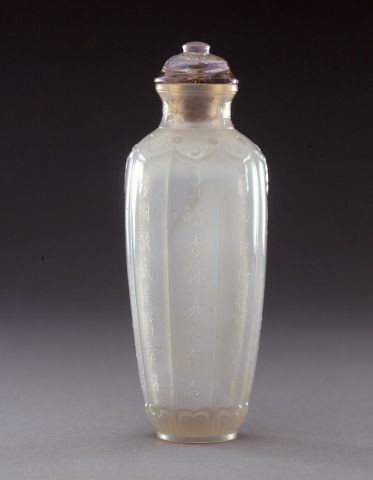
Bottle ID: 160
CARVED, CYLINDRICAL, IMPERIAL
Date: 1783
Height: 64 mm
Chalcedony, superbly hollowed, of dappled pale gray tones, of tapering cylindrical form with shoulders sloping to an everted mouth and with a neatly carved footrim, the main body with eight vertical lobes rising from a band of formalized lotus petals around the base and ending at the shoulders in a mantel of formalized lingzhi fungus heads, each set above three raised bosses to simulate pendant jewels, the neck with a single band of two alternating flower-heads, the lobed panels incised with a poem directly relating the bottle to the Qianlong Emperor for his personal use, followed by Qianlong guimao qiuqiyue (made during the seventh autumn month of the guimao year, 1783, of the Qianlong period), Yushang (for the appreciation of the Emperor), and Huajin tang zhi (made for, or at, the Hall of Brilliant Paintings), the base inscribed in seal script Qianlong nianzhi (made in the Qianlong Period). Imperial, attributed to the Palace Workshops, Beijing.
Similar Examples:
Crane Collection nos. 130 and 176
Lawrence, Clare. Miniature Masterpieces from the Middle Kingdom - The Monimar Collection of Chinese Snuff Bottles, 1996, pp. 118-119, no. 53.160.
Moss, Hugh, Victor Graham and Ka Bo Tsang. The Art of the Chinese Snuff Bottle - The J & J Collection, 1993, Vol. I, pp. 260-262, no. 164.
Stevens, Bob C. The Collector's Book of Snuff Bottles, 1976, p. 141, no. 530.
Sotheby's, New York, September 14, 2010, lot 50, The Joe Grimberg Collection.
Provenance:
Hugh Moss [HK] Ltd.
Sotheby's, Hong Kong, October 28, 1992, lot 407
There are a number of bottles from this group published, and it seems that they were made in a variety of colors of agate, though most of them seems to be, like this example in a tone of pale gray. The Monimar example however, is fashioned from a piece of lightly banded agate suggesting that these bottles were either made in sets, or were simply very popular in the late Qianlong Court. It has been suggested in the past that this group may be part of a later nineteenth or early twentieth century group, imitating Imperial wares. The Crane example however positively refutes that position with the clear references in its inscriptions. The poem itself was composed for this bottle and suggests that it was specifically made for the Emperor, with a reference to it being carried on his person and 'flowing with the dragons' on his robes when he moves. The designation of Yushang - for the appreciation of the Emperor - is not only a very high imperial mark, but also a very personal mark, and given in combination with a specific known personal hall, suggest that this bottle was made for the Emperor's use. With a formally correct reign mark and a given date of 1783, within the Qianlong period, it can be concluded that the whole group is genuine and of the late Qianlong period, made from around 1760 until the end of the reign. That being said, since the publication of a number of these bottles, many outright fakes have been produced, usually of a lesser quality, but still good enough to initially fool collectors.

 English
English 中文
中文